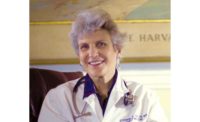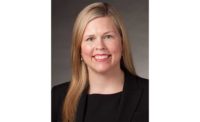Name: Cynthia (Cindy) A. Cogil
Age: 46
Title: Principal, SmithGroup
Educational Experience: M.S. architectural engineering, Pennsylvania State University, 1998; and B.S. architectural engineering, University of Kansas, 1995.
Professional Credentials/Accreditations: P.E. (Virginia, Illinois, Indiana, Wisconsin, Iowa) and LEED AP BD+C.
Organizational Affiliations/Achievements/Awards: ASHRAE member; ASHRAE Professional Development Committee, 2010-2013; ASHRAE National Capital Chapter, various committee chair, board and officer positions, 2006-2013; ASPE member; Clinton W. Phillips Service Award, National Capital Chapter ASHRAE, 2013; Penn State Architectural Engineering Centennial Fellow, 2010; CSE’s 40 under 40, 2008; Bisnow’s 35 under 35, 2007; Co-developer of the below-grade heat transfer model in the Lawrence Berkley National Lab (LBNL)/U.S. Department of Energy (DOE) EnergyPlus building energy simulation computer program, named by R&D magazine as one of the 100 most technologically significant new products of the year, December 2003; ASHRAE top nominee for 2003 “New Faces of Engineering” Program. Published in USA Today, Feb. 17, 2003 and on www.eweek.org; first place in Region III ASHRAE Technology Award, “New Commercial,” September 2001 for the Chesapeake Bay Foundation’s Philip Merrill Environmental Center; authored and co-authored an article in Engineered Systems and the ASHRAE Journal, respectively; Speaker at ASHRAE, Building Performance Analysis and SimBuild, GreenBuild International, and I2SL conferences.
When did you fall in love with engineering?
I fell in love with engineering during my study abroad year at Strathclyde University in Glasgow, Scotland. The curriculum required hands-on collaboration by student teams, an approach that mimicked real-life. It also highlighted regional issues specific to the Scottish climate and challenged us to apply engineering problem solving to explore solutions. It was through these experiences that engineering for the betterment of humanity became tangible to me.
What has been the most rewarding aspect of working in the skilled trades?
While it is fulfilling to see my work become reality, I think the most rewarding aspect of what I do is knowing that the work done by me and my team has a positive impact on people and the environment.
What challenges do women face in this profession? Why aren’t there more women in engineering?
Historically, there weren’t a lot of women in the profession to encourage young women to consider a future career in engineering. Those who found their way into the profession generally discovered that they had to work harder to gain the confidence of their colleagues and clients, while their male counterparts were often given the benefit of the doubt. Today, women engineers have unprecedented access to leadership positions, but they continue to be challenged with advancing their careers while growing their family and maintaining work-life balance.
Describe what your job entails on a day-to-day basis.
The one thing I can say with certainty is that no two days are alike. I approach each day with a list of tasks I plan to accomplish but acknowledge that nearly half my time goes to the “unexpected.” This might be a quick turnaround marketing proposal for new work, a check-in with a member of my staff whom I coach, an urgent request from a colleague to brainstorm a solution to a challenging issue, a client request to explore additional options, or an unforeseen condition at a job site.
What drives/motivates you every day?
It’s not enough to just be good at your craft from a technical perspective. A good engineer needs to know and empathize with what motivates their clients, the communities in which they work, and the individuals that make up their staff and project teams. A good engineer also knows how to communicate their ideas. I am driven by the healthy challenges I face every day that allow me to continuously learn, develop, and make meaningful contributions.
Describe the proudest moment in your career.
Early on in my career, I was fortunate to work on the Chesapeake Bay Foundation Philip Merrill Environmental Center, the first LEED Platinum certified building in the U.S. The experience shaped my design ethic and focus on sustainability. A little more than a decade later I was proud to work again with the same client and architect in my firm, Greg Mella, to design the Brock Environment Center, which achieved the prestigious Living Building Challenge Certification for zero energy, water, and waste.
What remains on your engineering bucket list — what do you aspire to do that you haven’t done yet?
I realized about 10 years into my career that not only was the profession immensely large and complex, but technology advances present an infinite path of learning that has no end. I don’t have a specific bucket list of finite goals, but I have adopted a philosophy to view challenges as a growth opportunity and to appreciate the rare chance to do something twice as an opportunity to further master a skill and to innovate.
What’s one thing no one knows about you?
I love to dance. I was part of a dance team in high school, where we choreographed and performed ballet, jazz, and tap, and I fell in love with merengue while in college.
List any mentors who’ve helped you succeed and describe exactly how they’ve shaped your success.
William (Bill) Bahnfleth – Dr. Bahnfleth was my thesis advisor at Penn State. He was my mentor, advocate, coach and friend. I’m grateful for his support and encouragement, not only during my time in graduate school but also for the past 20 years.
Brian Kong – Brian was my first supervisor at my first job out of graduate school. Our time working together was far too short, but Brian was the epitome of a well-rounded engineer. He was smart and skilled technically. He was also incredibly gracious with his clients and generous with his knowledge. He taught me the importance of giving back and sharing your knowledge with others.
George Karidis – George was the first person I met from SmithGroup and who got me interested in the firm. I relish every opportunity to collaborate with him. He is truly one of the giants in our industry whose playful curiosity drives innovation. George inspires me to keep asking questions.
Ted Manos – Ted served as project manager on a number of my projects. He was a cultural ambassador for integrated design. I observed and learned from him how empathy helps one to communicate effectively, motivate others, and negotiate difficult situations in a manner that ensures the dignity of all.
David King – David is a senior vice president and former chairman of the board at SmithGroup. I’ve been lucky enough to have been on project interview teams with him. Not only is his enthusiasm contagious, but he taught me the importance of always being genuine, authentic, and able to improvise.
What does the future hold for you?
Six years ago I made the decision to transfer to SmithGroup’s Chicago office to grow the building engineering disciplines. I look forward to working with my partners to continue to develop and expand our team. In addition, I’m honored to be a member of the newly formed leadership council that advises our board of directors. I’m excited to contribute my ideas and be a part of the governance of the longest continuously operating architectural engineering firm in the country.
What advice do you have for prospective female engineers considering entering the field?
Go for it. There are so many opportunities — don’t allow anything to hinder your success. Recognize that by being in the minority, you bring a unique and underrepresented perspective. Companies have evolved to recognize the important of diversity. Let your voice be heard.




